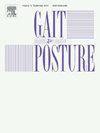Effects of elastic ankle braces and anticipation conditions on lower limb biomechanics during badminton lunge movements
IF 2.2
3区 医学
Q3 NEUROSCIENCES
引用次数: 0
Abstract
Objective
This study aimed to investigate the effects of wearing elastic ankle braces under anticipated and unanticipated conditions on lower limb biomechanics during badminton lunge steps and assess the associated risks of ankle and knee joint injuries.
Methods
Sixteen male badminton players performed left-front lunges in four scenarios (anticipated/unanticipated conditions× with/without brace), assessed via 3D motion capture (Qualisys, 200 Hz) and force plates (Kistler, 1000 Hz), a two-factor repeated measures ANOVA and Statistical Parametric Mapping (SPM) were used to analyze the data.
Results
Wearing ankle braces reduced the peak ankle inversion moment (p = 0.042) but increased the knee valgus angle of the movement (p < 0.006) compared to without brace under anticipated conditions. The main effect of unanticipation significantly increased the peak ankle inversion angle (p = 0.003) and knee varus moment (p = 0.024) compared to anticipated conditions.
Conclusion
Elastic ankle braces can potentially reduce ankle injury risk during badminton lunges but may increase stress on the knee joint, particularly under unanticipated conditions. These findings suggest that while ankle braces are beneficial for ankle protection, caution is needed due to their potential impact on knee joint mechanics.
弹性踝关节支架和预判条件对羽毛球弓步运动中下肢生物力学的影响
目的探讨在预期和非预期条件下佩戴弹性踝关节支具对羽毛球弓步运动中下肢生物力学的影响,并评估踝关节和膝关节损伤的相关风险。方法对16名男子羽毛球运动员在4种情况下(预期/非预期条件下,带/不带支具)进行左前弓步,采用3D动作捕捉(Qualisys, 200 Hz)和力板(Kistler, 1000 Hz)进行评估,采用双因素重复测量方差分析和统计参数Mapping (SPM)对数据进行分析。结果在预期条件下,使用踝关节支架与不使用踝关节支架相比,降低了踝关节翻转力矩峰值(p = 0.042),但增加了膝关节运动外翻角(p <; 0.006)。与预期情况相比,非预期的主要影响因素显著增加了踝关节最大内翻角(p = 0.003)和膝内翻力矩(p = 0.024)。结论弹性踝关节支架可以潜在地降低羽毛球弓步运动中踝关节损伤的风险,但可能会增加膝关节的压力,特别是在意外情况下。这些发现表明,虽然踝关节支架有益于踝关节保护,但由于其对膝关节力学的潜在影响,需要谨慎。
本文章由计算机程序翻译,如有差异,请以英文原文为准。
求助全文
约1分钟内获得全文
求助全文
来源期刊

Gait & posture
医学-神经科学
CiteScore
4.70
自引率
12.50%
发文量
616
审稿时长
6 months
期刊介绍:
Gait & Posture is a vehicle for the publication of up-to-date basic and clinical research on all aspects of locomotion and balance.
The topics covered include: Techniques for the measurement of gait and posture, and the standardization of results presentation; Studies of normal and pathological gait; Treatment of gait and postural abnormalities; Biomechanical and theoretical approaches to gait and posture; Mathematical models of joint and muscle mechanics; Neurological and musculoskeletal function in gait and posture; The evolution of upright posture and bipedal locomotion; Adaptations of carrying loads, walking on uneven surfaces, climbing stairs etc; spinal biomechanics only if they are directly related to gait and/or posture and are of general interest to our readers; The effect of aging and development on gait and posture; Psychological and cultural aspects of gait; Patient education.
 求助内容:
求助内容: 应助结果提醒方式:
应助结果提醒方式:


